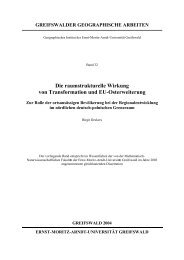Sustainability of sand dune restoration along the coast of ... - BioOne
Sustainability of sand dune restoration along the coast of ... - BioOne
Sustainability of sand dune restoration along the coast of ... - BioOne
Create successful ePaper yourself
Turn your PDF publications into a flip-book with our unique Google optimized e-Paper software.
94 De Lillis, M. et al.<br />
The present study was carried out on <strong>the</strong> Tyrrhenian<br />
<strong>coast</strong>line <strong>of</strong> Lazio, <strong>along</strong> <strong>the</strong> Roman littoral where,<br />
thanks to <strong>the</strong> protected areas <strong>of</strong> Castelfusano, Capocotta<br />
and Castelporziano, it has been possible to safeguard,<br />
at least in part, <strong>the</strong> inland <strong>dune</strong> environments. However,<br />
<strong>the</strong> series <strong>of</strong> mobile <strong>dune</strong>s facing <strong>the</strong> high tide<br />
mark is virtually absent. Along this <strong>coast</strong>line <strong>the</strong> elements<br />
<strong>of</strong> <strong>the</strong> various plant associations are forced back<br />
to <strong>the</strong> next belt, where <strong>the</strong>y are thus overlapping and<br />
compressed <strong>along</strong> a narrow and not very high <strong>dune</strong><br />
system.<br />
Restoration activities, mainly concerning <strong>dune</strong> nourishment<br />
by <strong>sand</strong> addition and marram grass plantations,<br />
have been carried out on <strong>the</strong> <strong>dune</strong> environments,<br />
from 40 to 80 m from <strong>the</strong> seashore, and <strong>the</strong>ir effectiveness<br />
and sustainability have been verified by five years<br />
<strong>of</strong> monitoring.<br />
Our aim was to investigate <strong>the</strong> morphological dynamics<br />
<strong>of</strong> <strong>the</strong> built up <strong>dune</strong> systems and <strong>the</strong> ecology <strong>of</strong><br />
<strong>the</strong> species present (germination characteristics and<br />
survival <strong>of</strong> <strong>the</strong> stabilizing species, rate <strong>of</strong> expansion <strong>of</strong><br />
<strong>the</strong> plant cover, and change in species richness). The<br />
main objectives <strong>of</strong> <strong>the</strong> study were:<br />
(1) to build up <strong>dune</strong> belts <strong>along</strong> <strong>the</strong> <strong>coast</strong>, located<br />
between <strong>the</strong> high water mark and <strong>the</strong> macchia vegetation<br />
behind this (consolidated <strong>dune</strong>s);<br />
(2) to verify <strong>the</strong> optimal distance from <strong>the</strong> sea for<br />
planting Ammophila littoralis on <strong>the</strong> <strong>dune</strong>s which had<br />
been built up;<br />
(3) to verify <strong>the</strong> sustainability <strong>of</strong> <strong>the</strong> <strong>restoration</strong> management.<br />
Material and Methods<br />
The study was carried out in <strong>the</strong> Castelporziano<br />
Presidential Estate, an area <strong>of</strong> considerable naturalistic<br />
interest due to its great floristic and faunistic diversity.<br />
The integrated management (<strong>dune</strong> nourishment and transplanted<br />
vegetation) was performed for ca. 3 km <strong>along</strong><br />
<strong>the</strong> <strong>sand</strong>y <strong>coast</strong>, where <strong>the</strong>re are no embryonic or shifting<br />
<strong>dune</strong>s.<br />
In June 1995, 40 <strong>dune</strong>s were built up, accumulating<br />
<strong>sand</strong> on a base <strong>of</strong> dry trunks and branches <strong>of</strong> Quercus<br />
species occurring in <strong>the</strong> estate; <strong>the</strong>se <strong>dune</strong>s were shaped<br />
according to <strong>the</strong> more or less elliptical morphology <strong>of</strong><br />
<strong>the</strong> already existing ones. The <strong>sand</strong> used, <strong>of</strong> equal grain<br />
size, was taken from <strong>the</strong> <strong>sand</strong>y area immediately inland<br />
in order to avoid <strong>the</strong> presence <strong>of</strong> seeds from o<strong>the</strong>r<br />
vegetation types. The 40 built-up <strong>dune</strong>s formed three<br />
belts located at different distances from <strong>the</strong> high water<br />
mark: 14 at a distance <strong>of</strong> < 40 m (33 - 40 m) from <strong>the</strong> sea,<br />
15 at a distance <strong>of</strong> 40 - 70 m, and 11 at a distance <strong>of</strong> > 70<br />
m (70 - 86 m).<br />
In January 1996 20 individuals <strong>of</strong> Ammophila<br />
littoralis, taken from <strong>the</strong> neighbouring <strong>dune</strong>s, were transplanted<br />
on each <strong>of</strong> 38 built-up <strong>dune</strong>s, and distributed<br />
evenly over <strong>the</strong>ir surface. In order to compare both <strong>the</strong><br />
evolution <strong>of</strong> <strong>the</strong> morphology and <strong>the</strong> natural colonization<br />
<strong>of</strong> <strong>the</strong> plant species in <strong>the</strong> absence <strong>of</strong> <strong>the</strong> stabilizing<br />
species, A. littoralis was not transplanted on to <strong>the</strong> last<br />
two <strong>dune</strong>s, at a distance <strong>of</strong> < 40 m from <strong>the</strong> sea.<br />
The phenology <strong>of</strong> <strong>the</strong> main species <strong>of</strong> <strong>the</strong> natural<br />
<strong>dune</strong> system was followed by means <strong>of</strong> monthly observations,<br />
from June 1995 until October 1996, in order to<br />
identify <strong>the</strong>ir growth and reproductive phases. At <strong>the</strong><br />
same time <strong>the</strong> fruits were collected and <strong>the</strong> seeds at<br />
various stages <strong>of</strong> maturation were isolated. In October<br />
1996 and in February, April and June 1997, germination<br />
trials were carried out on <strong>the</strong> main species present:<br />
Ammophila littoralis, An<strong>the</strong>mis maritima, Cyperus<br />
capitatus, Cakile maritima, Elymus farctus and Pancratium<br />
maritimum – to verify <strong>the</strong> reproductive capacity <strong>of</strong><br />
<strong>the</strong> seeds <strong>of</strong> each species.<br />
The experiments were carried out in <strong>the</strong> laboratory<br />
under controlled conditions (ISP standard conditions;<br />
Hendry & Grime 1993). Seeds were exposed to fluctuating<br />
light (PAR = 125 µmol.m 2 .s –1 over 14 hr) and<br />
temperature (15 °C by night; 22 °C by day); relative<br />
humidity was maintained at 95%. Seed was considered<br />
to have germinated <strong>the</strong> moment <strong>the</strong> first rootlet appeared.<br />
The minimum duration <strong>of</strong> <strong>the</strong> trial was 30 days,<br />
while <strong>the</strong> maximum duration depended on <strong>the</strong> species<br />
examined. The trial ended only when no fur<strong>the</strong>r germination<br />
occurred for a five-day period.<br />
The change in height and area <strong>of</strong> each <strong>dune</strong>, <strong>the</strong><br />
survival <strong>of</strong> A. littoralis, <strong>the</strong> change in cover, <strong>the</strong> appearance<br />
<strong>of</strong> new shoots and, lastly, <strong>the</strong> establishment <strong>of</strong> new<br />
species were monitored after 1 yr, 2 yr and 5 yr since <strong>the</strong><br />
starting phase. The cover <strong>of</strong> A. littoralis was measured as<br />
percentage <strong>of</strong> <strong>the</strong> surface covered in a grid-plot with eight<br />
subplots <strong>of</strong> 0.25 m 2 each.<br />
Statistical analysis was also performed, i.e. linear<br />
regression analysis and non-linear regression analysis<br />
was used to investigate relationships between floristic<br />
variables such as number <strong>of</strong> species, total plant cover,<br />
survival, cover, and production <strong>of</strong> new shoots <strong>of</strong> A.<br />
littoralis and <strong>the</strong> morphological and topographic characteristics<br />
<strong>of</strong> <strong>the</strong> <strong>dune</strong>s, such as distance from <strong>the</strong> sea,<br />
<strong>dune</strong> height and surface.<br />
We performed <strong>the</strong> t-test-PAST s<strong>of</strong>tware (Ryan et al.<br />
1995) on <strong>the</strong> data sets.




